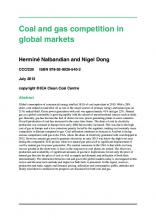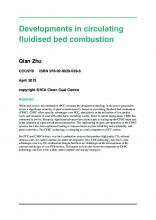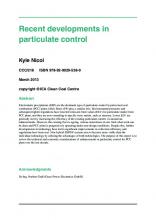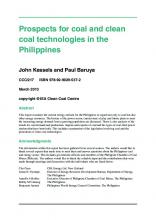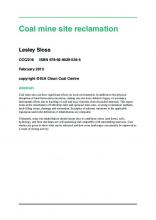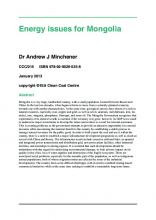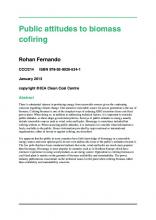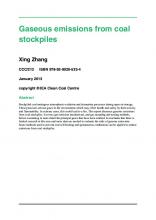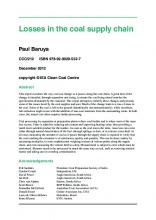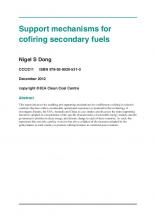July 1st, 2013
CCC/220 ISBN 978-92-9029-540-2
July 2013
copyright © IEA Clean Coal Centre
Abstract
Global consumption of commercial energy totalled 18 Gt of coal equivalent in 2010. With a 28%
share, coal ranked second after oil as one of the major sources of primary energy and natural gas (at
21%) ranked third. Gross power generation with coal was approximately 41% and gas 22%. Natural
gas as a global commodity is growing rapidly with the advent of unconventional sources such as shale
April 1st, 2013
CCC/219 ISBN 978-92-9029-539-6
April 2013
copyright © IEA Clean Coal Centre
Abstract
While pulverised coal combustion (PCC) remains the dominant technology in the power generation
sector, a significant minority of plant commissioned is based on circulating fluidised bed combustion
(CFBC). CFBC offers specific advantages over PCC, particularly in the utilisation of low quality
coals, and mixtures of coal with other fuels, including wastes. Since its initial deployment, CFBC has
March 1st, 2013
CCC/218 ISBN 978-92-9029-538-9
March 2013
copyright © IEA Clean Coal Centre
Abstract
Electrostatic precipitators (ESP) are the dominant type of particulate control in pulverised coal
combustion (PCC) plant; fabric filters (FF) play a smaller role. Environmental pressures and
subsequent tighter regulations have lowered emission limit values (ELV) for particulate matter from
PCC plant, and they are now extending to specific toxic metals, such as mercury. Lower ELV are
March 1st, 2013
CCC/217 ISBN 978-92-9029-537-2
March 2013
copyright © IEA Clean Coal Centre
Abstract
This report examines the current energy outlook for the Philippines in regard not only to coal but also
other energy resources. The history of the power sector, current state of play and future plans to meet
the increasing energy demand from a growing population are discussed. There is also analysis of the
trends for coal demand and production, imports and exports of coal and the types of coal-fired power
February 1st, 2013
CCC/216 ISBN 978-92-9029-536-5
February 2013
copyright © IEA Clean Coal Centre
Abstract
Coal mine sites can have significant effects on local environments. In addition to the physical
disruption of land forms and ecosystems, mining can also leave behind a legacy of secondary
detrimental effects due to leaching of acid and trace elements from discarded materials. This report
looks at the remediation of both deep mine and opencast mine sites, covering reclamation methods,
January 1st, 2013
CCC/215 ISBN 978-92-9029-535-8
January 2013
copyright © IEA Clean Coal Centre
Abstract
Mongolia is a very large, landlocked country, with a small population, located between Russia and
China. In the last two decades, it has begun reforms to move from a centrally-planned economy
towards one with market characteristics. At the same time, geological surveys have shown it is rich in
natural resources, especially coal, copper and gold, as well as silver, uranium, molybdenum, iron, tin,
January 1st, 2013
CCC/214 ISBN 978-92-9029-534-1
January 2013
copyright © IEA Clean Coal Centre
Abstract
There is substantial interest in producing energy from renewable sources given the continuing
concerns regarding climate change. One attractive renewable source for power generation is the use of
biomass. Cofiring biomass is one of the simplest ways of reducing GHG emissions from coal-fired
power plant. When doing so, in addition to addressing technical factors, it is important to consider
January 1st, 2013
CCC/213 ISBN 978-92-9029-533-4
January 2013
copyright © IEA Clean Coal Centre
Abstract
Stockpiled coal undergoes atmospheric oxidation and desorption processes during open air storage.
These processes release gases to the environment which may effect health and safety by their toxicity
and flammability. In extreme cases, this could lead to a fire. This report discusses gaseous emissions
from coal stockpiles. It covers gas emission mechanisms, and gas sampling and testing methods,
January 1st, 2013
CCC/212 ISBN 978-92-9029-532-7
December 2012
copyright © IEA Clean Coal Centre
Abstract
This report examines the way coal can change as it passes along the coal chain. A great deal of the
change is intended, through separation and sizing, to ensure the coal being mined matches the
specification demanded by the customer. This report attempts to identify these changes and presents
some of the issues faced by the coal supplier and user. Much of the change leads to a loss of mass in
January 1st, 2013
CCC/211 ISBN 978-92-9029-531-0
December 2012
copyright © IEA Clean Coal Centre
Abstract
This report discusses the enabling and supporting mechanisms for coal/biomass cofiring in selected
countries that have either considerable operational experience or potential in this technology. It
investigates Europe, the USA, Australia and China as case studies and discusses the main supporting
incentives adopted in consideration of the specific characteristics of renewable energy markets and the
Pages

